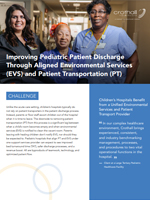
Improving Pediatric Patient Discharge Process in Children’s Hospitals
CHALLENGE
Unlike the acute care setting, children’s hospitals typically do not rely on patient transporters in the patient discharge process. Instead, parents or floor staff escort children out of the hospital when it is time to leave. The downside to removing patient transportation (PT) from this process is a significant lag between when a child’s room becomes empty and when environmental services (EVS) is notified to clean the vacant room. Parents leaving with healing children don’t notify EVS, nor should they be expected to. Pediatric hospitals that align PT and EVS under one support services provider can expect to see improved bed turnaround time (TAT), safer discharge processes, and a revenue boost. All are byproducts of teamwork, technology, and optimized patient flow.
Children’s Hospitals Benefit from a Unified Environmental Services and Patient Transport Provider
“In our complex healthcare environment, Crothall brings experienced, consistent, and industry benchmarking management, processes, and procedures to two vital operational functions in the hospital.” - Client at a Large Tertiary Pediatric Healthcare Facility
The Connection Between Patient Transportation Involvement at Discharge and Patient Experience, Safety, and Efficiency
"Using patient transportation at discharge provides a positive and consistent closure to our patients’ experience at our healthcare facility. Involving patient transportation at discharge also provides a safer discharge process for our post-surgical and long-stay inpatients. Lastly, we see a direct, positive correlation between using patient transportation at discharge and shorter inpatient room turnaround time, which naturally increases patient flow through our facility." - Client at a Large Tertiary Pediatric Healthcare Facility.
SOLUTION
Integrate Crothall patient transportation and environmental services within the same children’s hospital or system and leverage Crothall’s patient transportation dispatch software. Transporters are trained and equipped with programmed technology which automatically triggers a roomcleaning request to EVS the moment the transporter picks up the child and discharge is in process.
Involve PT in the patient discharge process. This removes unintentional burden placed on caregivers or nursing staff to notify EVS that a child’s room is empty. It also creates a consistent closure for all children and caregivers who visit the facility
Improve total hospital throughput and decrease turnaround time by reducing how long a child’s room sits vacant. Aligning patient transportation and environmental services also increases the speed with which pediatric patients can be moved to inpatient beds from the OR and the ED.
Best Case Scenario Before Aligning Patient Transportation and Environmental Services
"Prior to the Delayed Discharge Trigger Project, EVS response time without the use of patient transport was 60 minutes, and the room turnaround time was up to 111 minutes." - Client at a Large Tertiary Pediatric Healthcare Facility
Results
38 minutes decreased average EVS response time.
$626,000 annual revenue impact.
Improve patient flow.
Unified environmental services and patient transport services.
Better Than Expected Improvements
"The original goal of the project was to increase the use of patient transport for patient discharge to help with overall bed turnaround time (TAT). Realistically, we thought that the best we could do was reduce bed TAT by 10 minutes, but we far exceeded that expectation. Ultimately, we would like to continue to increase the use of patient transport and the software to drive bed TAT down to 60 minutes hospital-wide." - Nathan Cotterell, Patient Transportation Unit Director
Safe and Efficient, Always.
Experience the Compass One difference. Learn more about the tailored approach we take to Children’s Healthcare and let us know how we can help at your hospital.


